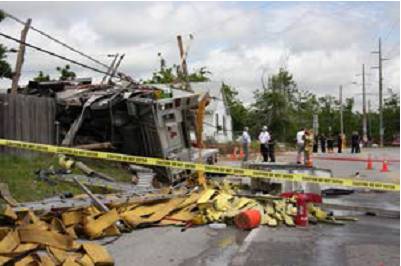Incident Report
Subject: USFA Report - Emergency Vehicle Safety Initiative (2014)
Date
of Email report: Thu 06/03/2014
Report Detail:

Fire truck accident
USFA report, Emergency Vehicle Safety Initiative (2014), provides best practices and recommendations for safer emergency vehicle and roadway incident response. Topics covered include common crash causes and crash prevention, internal and external factors for improving response and roadway safety, vehicle design and maintenance, and regulating emergency vehicle response and roadway scene safety.
Summary and Recommendations;
In analyzing all the information that is contained in the report, please note the following list of recommendations relative to improving emergency vehicle and roadway incident safety:
- There must be continued effort at the local, state and federal levels to support research and provide new information on this topic to emergency responders.
- Agencies that operate emergency vehicles and/or operate at roadway incident scenes shall use the information contained in these various research reports to strengthen their SOPs, training programs and incident operations.
- Design all new emergency vehicles to meet, as a minimum, the appropriate national consensus standards for that type of vehicle. Use the information contained in the various research reports regarding enhanced emergency vehicle visibility, conspicuity and lighting as a guide to exceed minimum standards and improve vehicle and scene safety, where applicable.
- Fully train all emergency vehicle drivers for each type of vehicle that they are expected or assigned to drive.
- All agencies within a given jurisdiction must work together to ensure that roadway incident response roles, policies and procedures among the agencies are defined, consistent, applied and enforced. Interagency training sessions are useful for ensuring appropriate handling of emergency incidents.
- Train all personnel who operate at roadway incident scenes to perform their roles according to local SOPs; mutual-aid agreements; and applicable local, state and federal laws and national standards.
- Ensure that all personnel wear appropriate personal protective clothing and retroreflective vests or garments when operating at incidents on or adjacent to a roadway. The only exceptions to wearing retroreflective vests or garments are when personnel are required to wear chemical protective suits or SCBA during the course of their duties.
- Thoroughly investigate all emergency vehicle response and roadway scene incidents to determine the circumstances and causal factors that played a role in the incident. This should include all near-miss, injury, fatal or otherwise unusual incidents. Use this information to amend policies and procedures, if necessary.
- Use the NIMS-ICS at all roadway incident scenes, and ensure that all agencies and personnel operate within the command structure.
- Develop departmental regulations that require that all emergency vehicles operate at a safe and controllable speed and that all members be seated and belted when the vehicle is in motion.
- Ensure that all vehicles that respond to roadway incidents are equipped with the appropriate types and amounts of traffic control equipment and at least one retroreflective vest for each person riding on the vehicle.
Additional Documentation:
Emergency Vehicle Safety Initiative |


